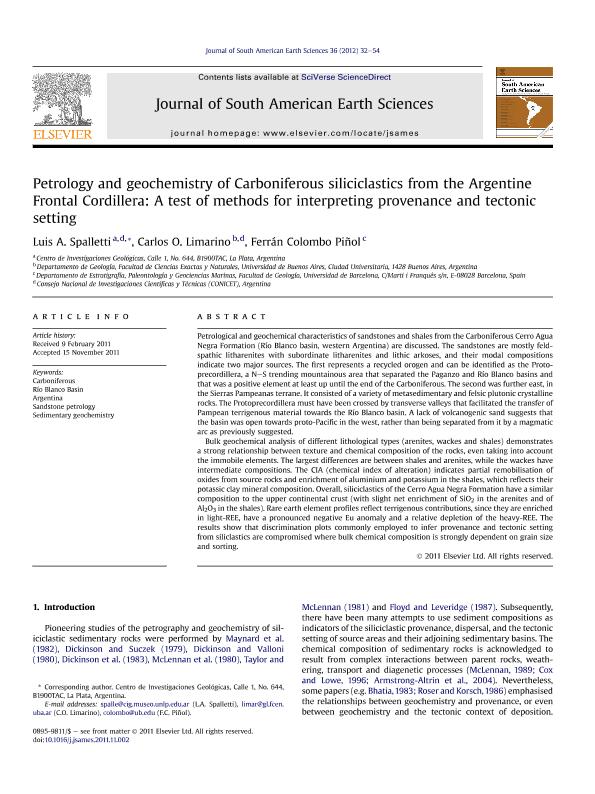Mostrar el registro sencillo del ítem
dc.contributor.author
Spalletti, Luis Antonio

dc.contributor.author
Limarino, Carlos Oscar

dc.contributor.author
Colombo Piñol, Ferran

dc.date.available
2019-01-24T18:06:30Z
dc.date.issued
2012-07
dc.identifier.citation
Spalletti, Luis Antonio; Limarino, Carlos Oscar; Colombo Piñol, Ferran; Petrology and geochemistry of Carboniferous siliciclastics from the Argentine Frontal Cordillera: A test of methods for interpreting provenance and tectonic setting; Pergamon-Elsevier Science Ltd; Journal of South American Earth Sciences; 36; 7-2012; 32-54
dc.identifier.issn
0895-9811
dc.identifier.uri
http://hdl.handle.net/11336/68510
dc.description.abstract
Petrological and geochemical characteristics of sandstones and shales from the Carboniferous Cerro Agua Negra Formation (Río Blanco basin, western Argentina) are discussed. The sandstones are mostly feldspathic litharenites with subordinate litharenites and lithic arkoses, and their modal compositions indicate two major sources. The first represents a recycled orogen and can be identified as the Protoprecordillera, a N-S trending mountainous area that separated the Paganzo and Río Blanco basins and that was a positive element at least up until the end of the Carboniferous. The second was further east, in the Sierras Pampeanas terrane. It consisted of a variety of metasedimentary and felsic plutonic crystalline rocks. The Protoprecordillera must have been crossed by transverse valleys that facilitated the transfer of Pampean terrigenous material towards the Río Blanco basin. A lack of volcanogenic sand suggests that the basin was open towards proto-Pacific in the west, rather than being separated from it by a magmatic arc as previously suggested.Bulk geochemical analysis of different lithological types (arenites, wackes and shales) demonstrates a strong relationship between texture and chemical composition of the rocks, even taking into account the immobile elements. The largest differences are between shales and arenites, while the wackes have intermediate compositions. The CIA (chemical index of alteration) indicates partial remobilisation of oxides from source rocks and enrichment of aluminium and potassium in the shales, which reflects their potassic clay mineral composition. Overall, siliciclastics of the Cerro Agua Negra Formation have a similar composition to the upper continental crust (with slight net enrichment of SiO 2 in the arenites and of Al 2O 3 in the shales). Rare earth element profiles reflect terrigenous contributions, since they are enriched in light-REE, have a pronounced negative Eu anomaly and a relative depletion of the heavy-REE. The results show that discrimination plots commonly employed to infer provenance and tectonic setting from siliclastics are compromised where bulk chemical composition is strongly dependent on grain size and sorting.
dc.format
application/pdf
dc.language.iso
eng
dc.publisher
Pergamon-Elsevier Science Ltd

dc.rights
info:eu-repo/semantics/openAccess
dc.rights.uri
https://creativecommons.org/licenses/by-nc-sa/2.5/ar/
dc.subject
Argentina
dc.subject
Carboniferous
dc.subject
Río Blanco Basin
dc.subject
Sandstone Petrology
dc.subject
Sedimentary Geochemistry
dc.subject.classification
Meteorología y Ciencias Atmosféricas

dc.subject.classification
Ciencias de la Tierra y relacionadas con el Medio Ambiente

dc.subject.classification
CIENCIAS NATURALES Y EXACTAS

dc.title
Petrology and geochemistry of Carboniferous siliciclastics from the Argentine Frontal Cordillera: A test of methods for interpreting provenance and tectonic setting
dc.type
info:eu-repo/semantics/article
dc.type
info:ar-repo/semantics/artículo
dc.type
info:eu-repo/semantics/publishedVersion
dc.date.updated
2019-01-16T18:19:53Z
dc.journal.volume
36
dc.journal.pagination
32-54
dc.journal.pais
Estados Unidos

dc.description.fil
Fil: Spalletti, Luis Antonio. Consejo Nacional de Investigaciones Científicas y Técnicas. Centro Científico Tecnológico Conicet - La Plata. Centro de Investigaciones Geológicas. Universidad Nacional de La Plata. Facultad de Ciencias Naturales y Museo. Centro de Investigaciones Geológicas; Argentina
dc.description.fil
Fil: Limarino, Carlos Oscar. Consejo Nacional de Investigaciones Científicas y Técnicas. Oficina de Coordinación Administrativa Ciudad Universitaria. Instituto de Geociencias Básicas, Aplicadas y Ambientales de Buenos Aires. Universidad de Buenos Aires. Facultad de Ciencias Exactas y Naturales. Instituto de Geociencias Básicas, Aplicadas y Ambientales de Buenos Aires; Argentina
dc.description.fil
Fil: Colombo Piñol, Ferran. Universidad de Barcelona; España
dc.journal.title
Journal of South American Earth Sciences

dc.relation.alternativeid
info:eu-repo/semantics/altIdentifier/doi/https://doi.org/10.1016/j.jsames.2011.11.002
dc.relation.alternativeid
info:eu-repo/semantics/altIdentifier/url/https://www.sciencedirect.com/science/article/pii/S0895981111001532
Archivos asociados
